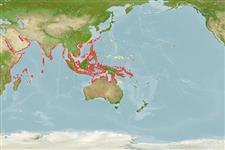>
Eupercaria/misc (Various families in series Eupercaria) >
Lutjanidae (Snappers) > Lutjaninae
Etymology: Lutjanus: Malay, ikan lutjan, name of a fish.
Eponymy: Dr Christian Gottfried Ehrenberg (1795–1876) was a German naturalist, comparative anatomist and microscopist; one of the foremost scientists of his time. [...] (Ref. 128868), visit book page.
More on author: Peters.
Environment: milieu / climate zone / intervalo de profundidade / distribution range
Ecologia
marinhas; Água doce; estuarina associadas(os) a recifes; intervalo de profundidade 5 - 20 m (Ref. 9710). Tropical; 30°N - 18°S, 31°E - 165°E (Ref. 55)
Indo-West Pacific: Red Sea and East Africa to the Solomon and Mariana islands.
Length at first maturity / Tamanho / Peso / Idade
Maturidade: Lm 20.1, range 12 - ? cm
Max length : 35.0 cm TL macho/indeterminado; (Ref. 55); common length : 20.0 cm TL macho/indeterminado; (Ref. 55)
Espinhos dorsais (total) : 10; Raios dorsais moles (total) : 13 - 14; Espinhos anais: 3; Raios anais moles: 7 - 9. This species is distinguished by the following characters: body moderately deep; greatest depth 2.5-3.0 in SL; preopercular notch and knob poorly developed; vomerine tooth patch triangular, with a medial posterior extension; gill rakers of first gill arch 6-7 + 10-14 - 16-21; caudal fin truncate to slightly emarginate; scale rows on back parallel to lateral line. Colour of back and upper sides dark brown, lower sides and belly whitish with a silver sheen; usually a series of 4-5 narrow yellow stripes on the sides below the lateral line; a distinct round, black spot on the back below the posterior part of the spinous portion of the dorsal fin (Ref. 9821, 90102).
Body shape (shape guide): fusiform / normal; Cross section: oval.
Adults inhabit very shallow coastal habitats, often in large schools near freshwater run-offs (Ref. 48635). Juveniles often intertidal (Ref. 48635); over sand, silt, or coral rubble bottoms, occasionally in mangrove-lined streams and estuaries (Ref. 9821) They may enter freshwater to feed (Ref. 245); on small fish and invertebrates (Ref. 5213). This is a small species commonly utilized in subsistence fisheries and also seen in markets. Caught mainly with handlines, traps, and gill nets and are marketed mostly fresh (Ref. 9821).
Life cycle and mating behavior
Maturidade | Reprodução | Desova | Ovos | Fecundidade | Larvas
Allen, G.R., 1985. FAO Species Catalogue. Vol. 6. Snappers of the world. An annotated and illustrated catalogue of lutjanid species known to date. FAO Fish. Synop. 125(6):208 p. Rome: FAO. (Ref. 55)
Categoria na Lista Vermelha da IUCN (Ref. 130435: Version 2025-1)
Ameaça para o homem
Harmless
Utilização humana
Pescarias: pouco comercial
Ferramentas
Relatórios especiais
Descarregue XML
Fontes da internet
Estimates based on models
Preferred temperature (Ref.
123201): 25.9 - 29.3, mean 28.6 °C (based on 2891 cells).
Phylogenetic diversity index (Ref.
82804): PD
50 = 0.5000 [Uniqueness, from 0.5 = low to 2.0 = high].
Bayesian length-weight: a=0.01622 (0.01038 - 0.02533), b=2.95 (2.83 - 3.07), in cm total length, based on LWR estimates for this species & Genus-body shape (Ref.
93245).
Nível Trófico (Ref.
69278): 3.6 ±0.53 se; based on food items.
Generation time: 4.4 ( na - na) years. Estimated as median ln(3)/K based on 2
growth studies.
Resiliência (Ref.
120179): Elevada, tempo mínimo de duplicação da população menor que 15 meses (Preliminary K or Fecundity.).
Fishing Vulnerability (Ref.
59153): Low vulnerability (19 of 100).
🛈
Nutrients (Ref.
124155): Calcium = 56.1 [33.6, 96.4] mg/100g; Iron = 0.49 [0.30, 0.85] mg/100g; Protein = 18.8 [17.3, 20.2] %; Omega3 = 0.137 [0.085, 0.225] g/100g; Selenium = 51 [28, 92] μg/100g; VitaminA = 153 [28, 664] μg/100g; Zinc = 0.563 [0.396, 0.837] mg/100g (wet weight);
